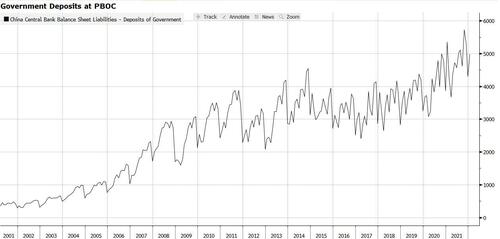What’s Behind The PBOC’s 1 Trillion Yuan Transfer
By Ye Xie, Bloomberg Markets Live reporter and analyst
The People’s Bank of China disclosed that it will transfer more than 1 trillion yuan ($158 billion) in profits to the government to help fund fiscal spending. The move has created confusion and debate among investors. Is this the Chinese version of QE or Modern Monetary Theory? Is it equivalent to a cut in the reserve requirement ratio? If so, does it reduce the need for more easing?
The reality is that it is more technical than substantial in terms of its impact on monetary and fiscal policies.
The PBOC said Tuesday it will transfer profits from income accumulated on its $3.2 trillion foreign-exchange reserves to the Ministry of Finance. The money will be used mainly on tax rebates for companies and to bolster the finances of local governments.
-
First: It’s NOT a new initiative. By law, the PBOC is required to turn over its profits to the government. The PBOC just chose to publicly disclose this routine operation, which was interrupted by the pandemic since 2020. In fact, it’s a common practice internationally. Last year, the Federal Reserve sent almost all of its net income of $107 billion — primarily derived from interest income on securities acquired through open-market operations — to the U.S. Treasury. The Bank of Mexico has done the same.
-
It’s NOT additional fiscal stimulus. The transfer is likely already factored into the proposed 2022 fiscal budget unveiled at the People’s National Congress over the weekend, according to economists at Nomura and Goldman Sachs. The move simply addressed the question of where the money will come from to support spending the government has proposed.
-
It’s NOT monetizing government debt. Unlike QE, the transfer itself doesn’t involve printing new money. It’s moving from one account (retained profits) at the PBOC to another (government deposits), without changing the size of its balance sheet.
-
Is it equivalent to a RRR cut? Not exactly. As mentioned above, the transfer itself doesn’t affect liquidity. Only when the money is spent by the government will it leak into the financial system, a similar effect to when the PBOC releases funds via a RRR cut. But even then, the impact is much more muted because the profits likely will be spread out over a 12-month period, rather than be a one-off. The money-multiple effect is also likely to be different. In other words, this move doesn’t reduce the need for RRR cuts. Economists at Goldman and Citigroup both expect further RRR and rate cuts in the first half of the year.
-
Will it affect the exchange rate? Most likely not. Given the PBOC probably doesn’t want further yuan appreciation, the transfer likely doesn’t involve the exchange of currencies, according to Nomura. Instead of selling foreign reserves, the profit transfer may come from the proceeds of interest payments to the PBoC by various borrowers, especially commercial banks, wrote Nomura’s economist Lu Ting and his colleagues.
All told, it sounds more like inside baseball than a game changer.
Tyler Durden
Thu, 03/10/2022 – 14:00
Zero Hedge’s mission is to widen the scope of financial, economic and political information available to the professional investing public, to skeptically examine and, where necessary, attack the flaccid institution that financial journalism has become, to liberate oppressed knowledge, to provide analysis uninhibited by political constraint and to facilitate information’s unending quest for freedom. Visit https://www.zerohedge.com

